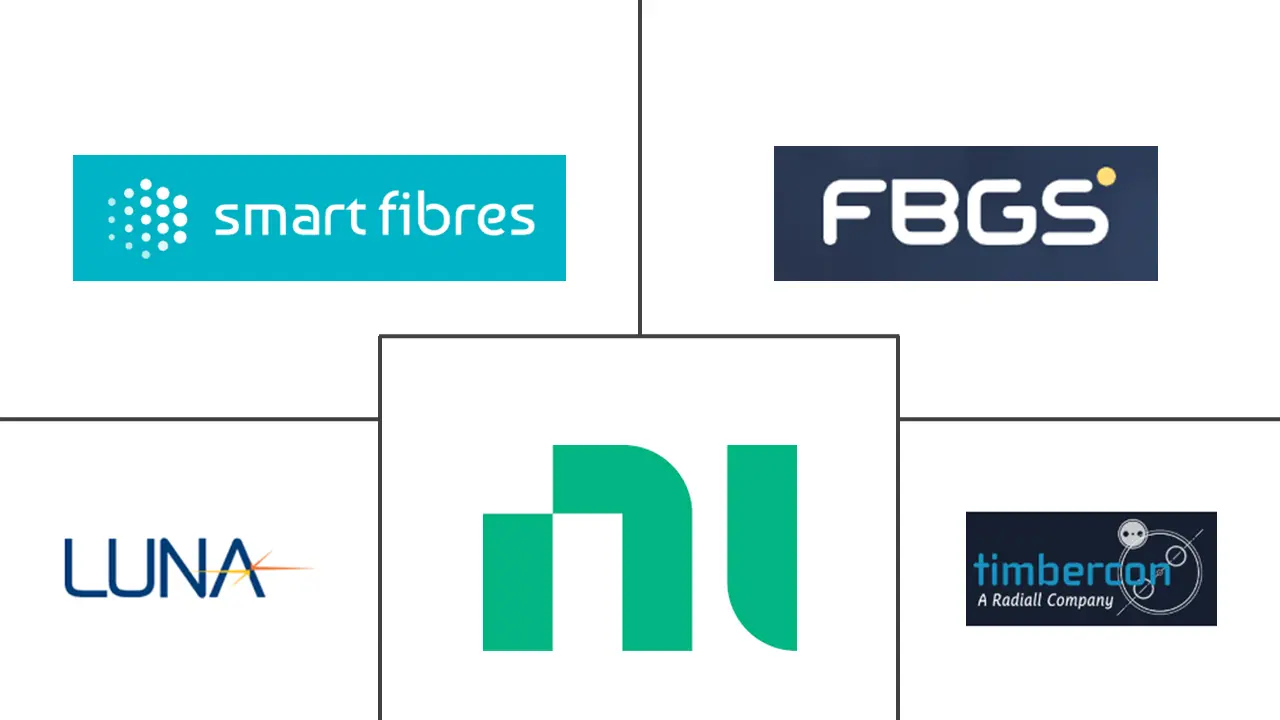Fiber Bragg Grating Sensor Market Size and Share
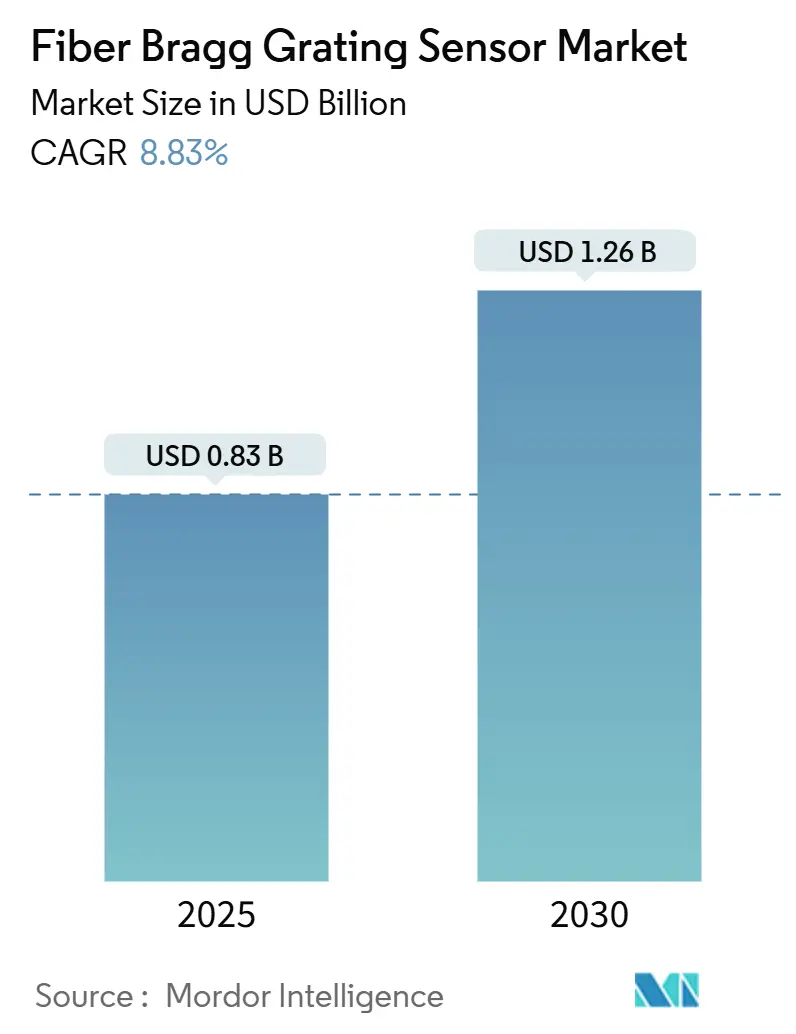
Fiber Bragg Grating Sensor Market Analysis by Mordor Intelligence
The Fiber Bragg Grating Sensor market size is estimated at USD 0.83 billion in 2025 and is projected to reach USD 1.26 billion by 2030, growing at an 8.83% CAGR. The surging adoption of structural health monitoring, hydrogen pipelines, smart mining, and 5G backhaul infrastructure underpins this steady trajectory. Competitive differentiation centers on wavelength-dense sensor networks, multi-parameter measurement capabilities, and artificial intelligence-based signal processing. Rising infrastructure investments, safety-centric regulations, and the operational limits of traditional electrical gauges jointly favor optical sensing. Nevertheless, cross-sensitivity between temperature and strain, as well as higher upfront installation costs, continue to moderate near-term adoption in price-sensitive deployments.
Key Report Takeaways
- By type, strain sensors led with 38.13% revenue share in 2024, while acoustic sensors are projected to advance at a 9.26% CAGR through 2030.
- By grating wavelength range, the C-Band commanded a 45.66% share of the Fiber Bragg Grating Sensor market size in 2024; L-Band devices registered the strongest growth outlook at a 9.48% CAGR to 2030.
- By end-user industry, the aerospace and defense sector dominated with 28.71% of the Fiber Bragg Grating Sensor market share in 2024, while the oil and gas sector is forecast to grow fastest at an 8.91% CAGR.
- By application, structural health monitoring accounted for a 33.74% share in 2024, and vibration and acoustic monitoring are expected to expand at an 8.98% CAGR to 2030.
- By geography, North America accounted for 35.67% of 2024 revenues, whereas the Asia-Pacific region is expected to post a 9.32% CAGR up to 2030.
Global Fiber Bragg Grating Sensor Market Trends and Insights
Drivers Impact Analysis
| Driver | (~) % Impact on CAGR Forecast | Geographic Relevance | Impact Timeline |
|---|---|---|---|
| Growing demand for real-time structural health monitoring | +2.1% | Global with North America and Europe concentration | Medium term (2-4 years) |
| Adoption in hydrogen pipeline networks | +1.8% | Europe and North America, expanding to Asia-Pacific | Long term (≥ 4 years) |
| Rising investments in smart mining operations | +1.4% | Asia-Pacific core, spill-over to South America and Africa | Medium term (2-4 years) |
| Expansion of 5G fiber backhaul infrastructure | +1.6% | Global, led by Asia-Pacific and North America | Short term (≤ 2 years) |
| Increasing use in high-voltage direct current cables | +1.2% | Europe and Asia-Pacific, expanding globally | Long term (≥ 4 years) |
| Defense focus on condition-based aircraft maintenance | +0.9% | North America and Europe, selective Asia-Pacific markets | Medium term (2-4 years) |
| Source: Mordor Intelligence | |||
Growing Demand for Real-Time Structural Health Monitoring
Aging bridges, tunnels, and high-rise buildings are now monitored continuously with dense arrays of fiber Bragg gratings that reveal fatigue cracks and patterns of load redistribution before structural failure. The 2024 Francis Scott Key Bridge collapse accelerated federal mandates for continuous monitoring on high-traffic corridors in the United States.[1]Federal Highway Administration, “Bridge Inspection and Tunnel Assessment Guidelines,” fhwa.dot.gov Distributed sensing along entire girders creates a complete strain profile, replacing scattered electrical gauges that overlook early-stage anomalies. Similar regulations in Europe tie public-funded infrastructure upgrades to the adoption of optical sensing, positioning the Fiber Bragg Grating Sensor market for long-term demand in civil assets.
Adoption in Hydrogen Pipeline Networks
Europe’s Hydrogen Backbone initiative requires leak detection systems immune to hydrogen embrittlement, elevating fiber Bragg gratings as a safety standard.[2]European Hydrogen Backbone, “Analysing the Future Demand, Supply and Transport of Hydrogen,” ehb.eu Dual-mode acoustic and strain detection enables operators to spot micro-leaks and mechanical deformation simultaneously, a capability that electrical systems cannot deliver in the corrosive hydrogen environment. Germany’s H2-Netz specifications for new transmission lines create a replicable template that North American and Asia-Pacific projects are beginning to follow, widening the Fiber Bragg Grating Sensor market footprint in energy transport infrastructure.
Rising Investments in Smart Mining Operations
Mining majors in Australia and China equip conveyor systems, tailings dams, and underground roadways with intrinsically safe optical arrays that function where electrical devices risk ignition. Rio Tinto reported a 40% reduction in downtime after linking distributed strain data to predictive analytics across Pilbara iron-ore operations.[3]Rio Tinto, “Rio Tinto Advances Autonomous Mining Operations with Advanced Sensing Technology,” riotinto.com Expanding regulatory oversight on ground movement in South American copper pits and African gold mines extends the regional relevance, propelling incremental volumes for the Fiber Bragg Grating Sensor market.
Expansion of 5G Fiber Backhaul Infrastructure
High-density 5G rollouts embed fiber Bragg gratings inside telecom cables, allowing operators to pinpoint stress points and construction-related damage. Verizon trimmed cable repair time from hours to minutes by localizing faults on live fiber spans. Asian carriers replicating this model in dense urban corridors scale demand rapidly in the short term, keeping the Fiber Bragg Grating Sensor market on an upward growth curve despite capex headwinds at some operators.
Restraints Impact Analysis
| Restraint | (~) % Impact on CAGR Forecast | Geographic Relevance | Impact Timeline |
|---|---|---|---|
| Cross-sensitivity to temperature and strain | -1.3% | Global, acute in extreme climate regions | Short term (≤ 2 years) |
| High upfront installation cost versus electrical gauges | -1.8% | Price-sensitive markets in developing regions | Medium term (2-4 years) |
| Limited dynamic range in ultra-fast events | -0.7% | Applications requiring high-speed measurements | Long term (≥ 4 years) |
| Scarcity of skilled fiber-optic technicians | -1.1% | Global, acute in emerging markets | Medium term (2-4 years) |
| Source: Mordor Intelligence | |||
Cross-Sensitivity to Temperature and Strain
Separating mechanical strain from thermal effects still necessitates costly dual-grating configurations or computational compensation that introduce 5-10% measurement uncertainty in aerospace and energy applications. Customers seeking ±1% accuracy often resort to redundant sensor schemes, which raises project budgets and hinders adoption in environments with wide thermal swings. This technical hurdle temporarily tempers the expansion of the Fiber Bragg Grating Sensor market until advanced compensation designs become price-competitive.
High Upfront Installation Cost versus Electrical Gauges
Complete optical monitoring packages cost three to five times more than conventional gauges once interrogation units, ruggedized cables, and skilled labor are included. Capital-constrained contractors in emerging economies tend to adopt fiber Bragg gratings sparingly, focusing on critical bridge spans or offshore risers rather than providing full-scale coverage. Although life-cycle cost advantages are compelling, board-level approval cycles slow the penetration trajectory of the Fiber Bragg Grating Sensor market in budget-sensitive segments.
Segment Analysis
By Type: Strain Leadership with Acoustic Acceleration
Strain sensors contributed USD 0.32 billion to the Fiber Bragg Grating Sensor market in 2024, retaining a 38.13% revenue share, which underscores their ubiquity across bridges, aircraft wings, and concrete structures. Acoustic variants, while smaller in absolute terms, show a 9.26% CAGR as distributed acoustic sensing gains traction in perimeter security and leak detection. Strain devices will continue to anchor flagship infrastructure projects, but acoustic systems provide a high-growth complement.
Multi-parameter hybrids that co-locate strain and temperature gratings on a single fiber are shrinking compensation errors and lowering channel counts. Oilfield service providers are increasingly favoring combined sensors to reduce wellbore completion complexity, thereby broadening the reach of the Fiber Bragg Grating Sensor market across downhole conditions where electronic gauges fail.
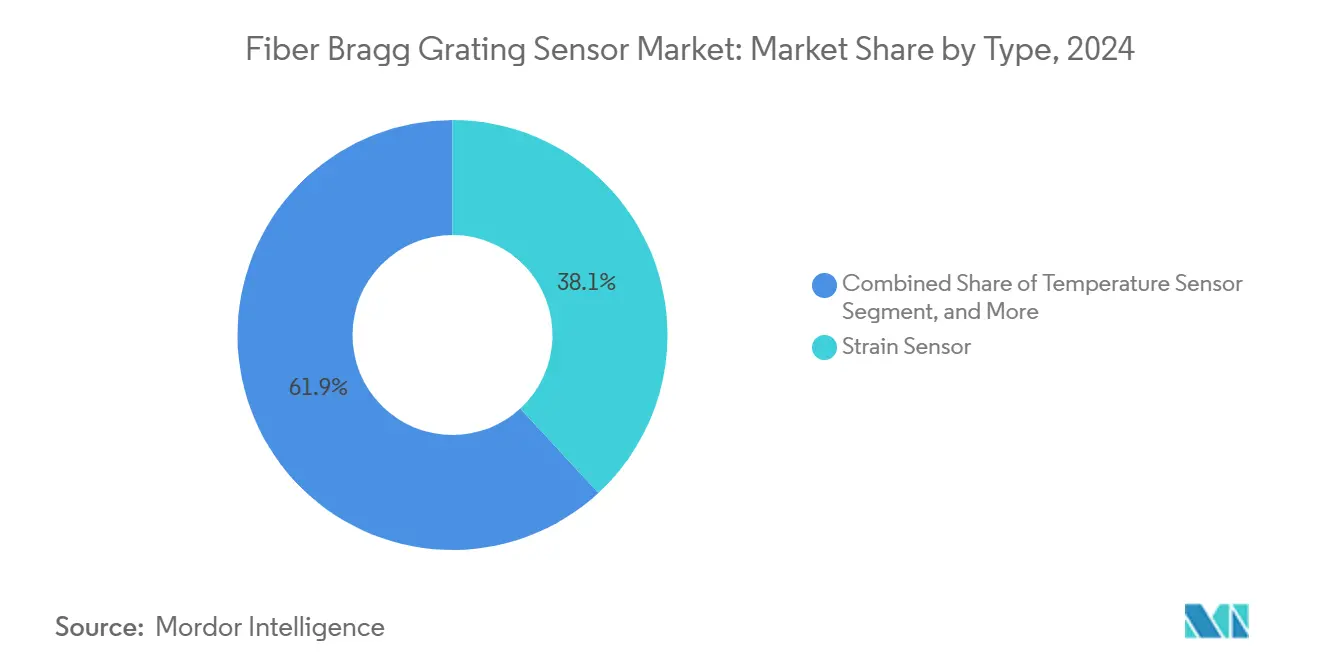
Note: Segment shares of all individual segments available upon report purchase
By Grating Wavelength Range: C-Band Dominance Faces L-Band Challenge
The dominant C-Band segment generated nearly USD 0.38 billion in 2024, driven by telecom-grade component availability and proven interrogation hardware. Network-scale projects exhaust available C-Band channels, driving migration to the L-Band, which is posting the fastest 9.48% CAGR. The Fiber Bragg Grating Sensor market size for L-Band devices is forecast to expand significantly as mega-projects demand hundreds of sensing points on a single fiber.
Advanced interrogators now sweep across C- and L-Bands simultaneously, enabling mixed architectures that balance component cost with channel density. Research consortia are testing broader O-Band arrays for niche biomedical and underwater applications, although commercialization remains modest compared to mainstream wavelengths.
By End-User Industry: Defense Dominance with Oil and Gas Upsurge
Aerospace and defense industries absorbed USD 0.24 billion in 2024, accounting for a 28.71% market share. Fighter aircraft and naval vessels adopt optical strain networks to mitigate electromagnetic interference and enable condition-based maintenance programs. In parallel, the oil and gas sector represents the fastest-growing customer bloc, adding sensors to wells, pipelines, and offshore platforms at an 8.91% CAGR and elevating its role within the Fiber Bragg Grating Sensor market.
Construction firms specify optical monitoring in new high-speed rail viaducts, while power utilities monitor transmission towers for ice loading. The mining and telecommunications segments round out demand, with safety and reliability objectives that align well with the technology’s intrinsic strengths.
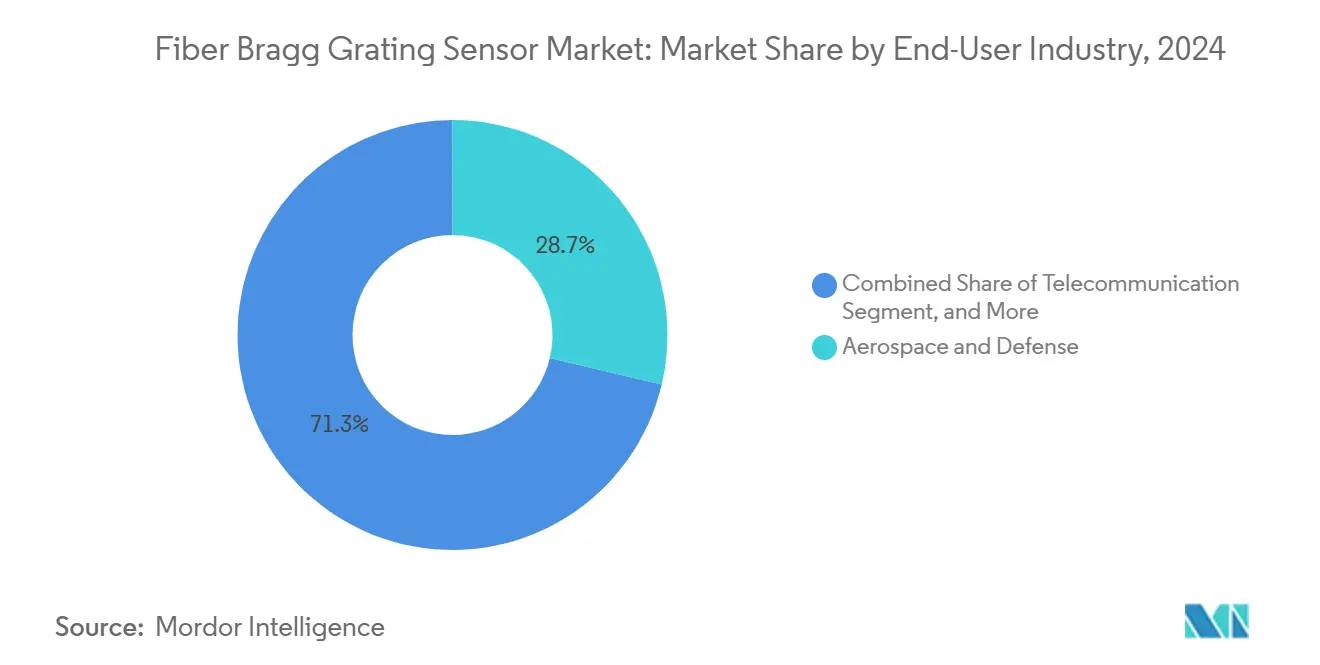
Note: Segment shares of all individual segments available upon report purchase
By Application: Structural Health Monitoring Dominance with Acoustic Upswing
Structural health monitoring accounts for USD 0.28 billion and 33.74% of global revenue, cementing its position as the historical anchor for the Fiber Bragg Grating Sensor market. Yet vibration and acoustic monitoring is scaling rapidly on an 8.98% CAGR trajectory as smart-city authorities deploy distributed acoustic sensing for traffic flow analytics and intrusion detection.
Temperature and pressure monitoring remain steady contributors in industrial process lines and downhole completions. Load and weight monitoring, powered by weigh-in-motion systems embedded in roadway pavements, is opening a new municipal revenue stream based on vehicle enforcement and asset wear forecasting.
Geography Analysis
\North American revenue leadership stems from mandated structural monitoring after catastrophic bridge failures. Federal grants subsidize installation on aging steel arches, and the U.S. Navy’s submarine hull integrity program extends military demand. Canada’s extreme temperature swings make optical sensors a logical choice for remote transmission lines prone to ice loading. Mexico adopts fiber arrays in automotive factories to reduce unplanned downtime, adding a nascent industrial layer to the regional Fiber Bragg Grating Sensor market.
Asia-Pacific’s dynamism is evident in China’s multi-province high-speed rail rollout, with each viaduct equipped with thousands of gratings to detect rotational slip and joint displacement. Japan’s stringent seismic codes drive real-time monitoring on new Shinkansen stations, while Korea integrates sensors into 5G trunk lines to localize fiber cuts within meters. India’s smart-city program funds pilot traffic-monitoring grids using distributed acoustic sensing on roadway shoulders, thereby expanding the addressable demand.
Europe benefits from standardized regulations that align hydrogen, wind, and rail projects under frameworks like IEC 61757. Germany’s H2-Ready pipeline criteria specify acoustic leak detection by default, and the United Kingdom’s Crown Estate requires optical monitoring on fixed and floating wind assets. Southern Europe channels recovery funds into high-speed rail that crosses seismic zones, mandating optical arrays for tunnel liner strain measurement, buttressing the regional Fiber Bragg Grating Sensor market outlook.
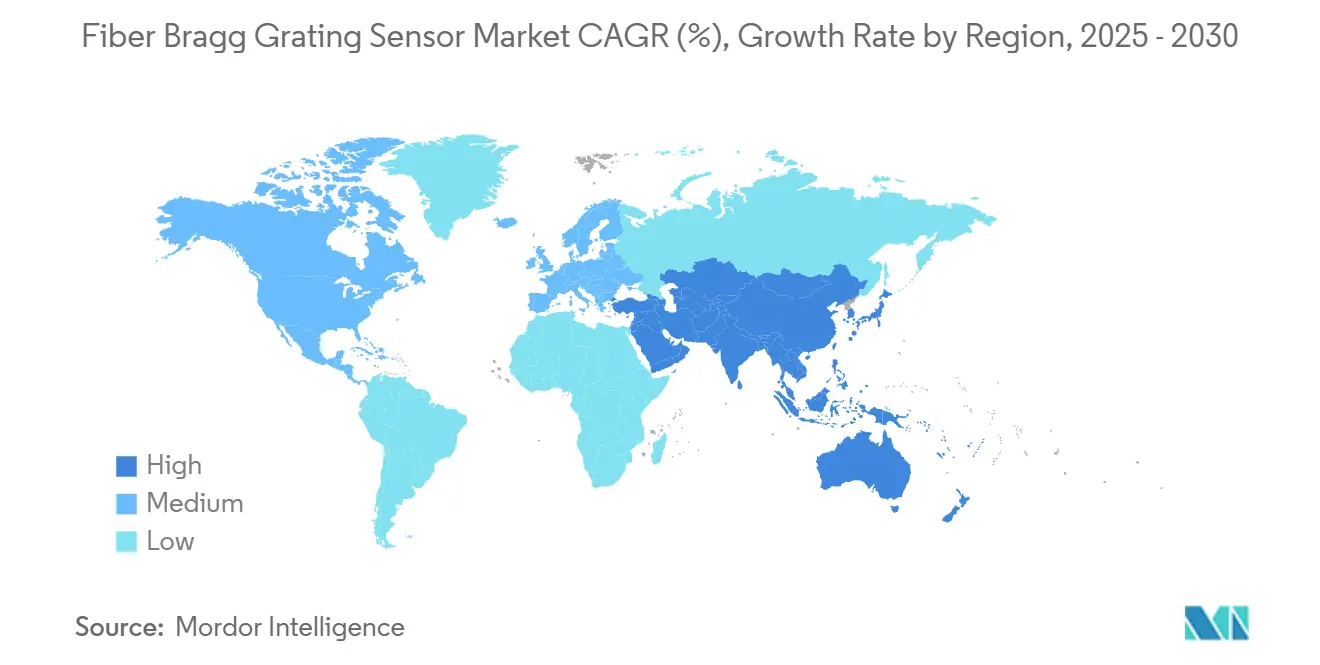
Competitive Landscape
The competitive arena features moderate fragmentation, with no vendor controlling more than 15% of the revenue. Market leaders Luna Innovations, FBGS International, and Hottinger Brüel & Kjær emphasize full-stack portfolios that span gratings, interrogators, and analytics software. Start-ups in Asia concentrate on cost-optimized gratings, while European specialists focus on harsh-environment coatings that withstand exposure to hydrogen or seawater.
Strategic moves include Luna’s post-acquisition integration of Micron Optics' interrogation firmware, which improves multi-band channel counts. FBGS partners with Siemens Energy to deliver offshore wind solutions that merge load and temperature monitoring in a single fiber. HBK leverages artificial intelligence algorithms to improve signal discrimination in high-vibration drilling rigs, expanding footholds in the oil and gas industry.
Patent filings trend toward temperature-compensated multi-parameter gratings and extended L-Band interrogation techniques. Industry alliances with telecom operators address in-cable sensing integration standards. As governments draft cybersecurity rules for critical infrastructure, vendors that embed secure communication stacks gain competitive leverage, sharpening the technology-plus-software differentiation line inside the Fiber Bragg Grating Sensor market.
Fiber Bragg Grating Sensor Industry Leaders
-
FBGS International NV
-
Smart Fibres Ltd
-
Micron Optics Inc - Luna Innovations
-
Timbercon Inc
-
National Instruments Corporation
- *Disclaimer: Major Players sorted in no particular order
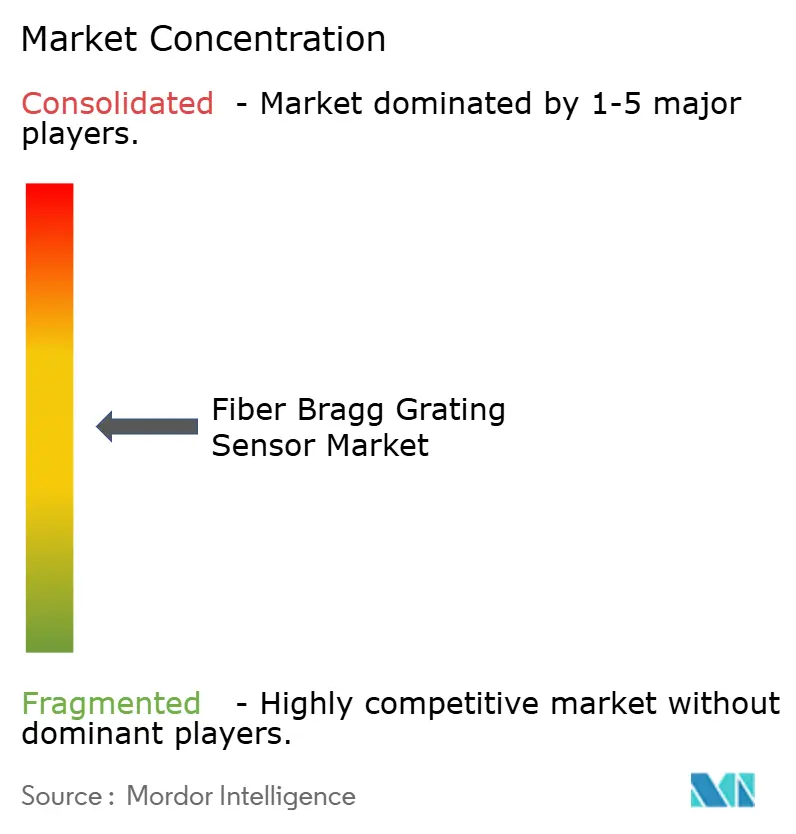
Recent Industry Developments
- October 2025: Luna Innovations won a USD 35 million contract from the European Space Agency to create radiation-hardened fiber Bragg grating sensors and interrogation units for the Artemis lunar program, enabling long-duration structural health monitoring in space.
- September 2025: FBGS International formed a strategic partnership with China State Construction Engineering Corporation to install more than 10,000 fiber Bragg grating sensors on the USD 2.8 billion Hong Kong-Zhuhai-Macao Bridge expansion, delivering continuous structural health monitoring for the world’s longest sea-crossing bridge.
- August 2025: Smart Fibres Ltd closed a USD 45 million Series C funding round led by Siemens Venture Capital, earmarking the proceeds for capacity expansion, AI-driven signal processing development, and a new aerospace manufacturing site in Seattle.
- July 2025: Hottinger Brüel and Kjær acquired Italian firm Optosensing Srl for USD 28 million, adding underwater sensing technology for offshore wind farms and extending its distributed acoustic sensing portfolio for subsea cable protection.
Global Fiber Bragg Grating Sensor Market Report Scope
A Fiber Bragg Grating (FBG) sensor is a lightweight sensor that can be installed effortlessly. It features the multiplexing capability of sensing various parameters, like temperature, strain, load, pressure, etc., on different points on the same sensor cable.
The Fiber Bragg Grating Sensor Market Report is Segmented by Type (Temperature Sensor, Strain Sensor, and More), Grating Wavelength Range (C-Band, L-Band, and More), End-User Industry (Telecommunication, Aerospace and Defense, and More), Application (Structural Health Monitoring, Temperature Monitoring, Vibration and Acoustic Monitoring, and More), and Geography. The Market Forecasts are Provided in Terms of Value (USD).
| Temperature Sensor |
| Strain Sensor |
| Pressure Sensor |
| Acoustic Sensor |
| Other Types |
| C-Band (1530-1565 nm) |
| L-Band (1565-1625 nm) |
| O-Band (1260-1360 nm) |
| Other Grating Wavelength Ranges |
| Telecommunication |
| Aerospace and Defense |
| Construction and Infrastructure |
| Energy and Power |
| Oil and Gas |
| Mining |
| Other End-User Industries |
| Structural Health Monitoring |
| Temperature Monitoring |
| Vibration and Acoustic Monitoring |
| Pressure Monitoring |
| Load and Weight Monitoring |
| Other Applications |
| North America | United States | |
| Canada | ||
| Mexico | ||
| Europe | Germany | |
| United Kingdom | ||
| France | ||
| Russia | ||
| Rest of Europe | ||
| Asia-Pacific | China | |
| Japan | ||
| India | ||
| South Korea | ||
| Australia | ||
| Rest of Asia-Pacific | ||
| Middle East and Africa | Middle East | Saudi Arabia |
| United Arab Emirates | ||
| Rest of Middle East | ||
| Africa | South Africa | |
| Egypt | ||
| Rest of Africa | ||
| South America | Brazil | |
| Argentina | ||
| Rest of South America | ||
| By Type | Temperature Sensor | ||
| Strain Sensor | |||
| Pressure Sensor | |||
| Acoustic Sensor | |||
| Other Types | |||
| By Grating Wavelength Range | C-Band (1530-1565 nm) | ||
| L-Band (1565-1625 nm) | |||
| O-Band (1260-1360 nm) | |||
| Other Grating Wavelength Ranges | |||
| By End-User Industry | Telecommunication | ||
| Aerospace and Defense | |||
| Construction and Infrastructure | |||
| Energy and Power | |||
| Oil and Gas | |||
| Mining | |||
| Other End-User Industries | |||
| By Application | Structural Health Monitoring | ||
| Temperature Monitoring | |||
| Vibration and Acoustic Monitoring | |||
| Pressure Monitoring | |||
| Load and Weight Monitoring | |||
| Other Applications | |||
| By Geography | North America | United States | |
| Canada | |||
| Mexico | |||
| Europe | Germany | ||
| United Kingdom | |||
| France | |||
| Russia | |||
| Rest of Europe | |||
| Asia-Pacific | China | ||
| Japan | |||
| India | |||
| South Korea | |||
| Australia | |||
| Rest of Asia-Pacific | |||
| Middle East and Africa | Middle East | Saudi Arabia | |
| United Arab Emirates | |||
| Rest of Middle East | |||
| Africa | South Africa | ||
| Egypt | |||
| Rest of Africa | |||
| South America | Brazil | ||
| Argentina | |||
| Rest of South America | |||
Key Questions Answered in the Report
How large is the global Fiber Bragg Grating Sensor market in 2025?
It is valued at USD 0.83 billion, with an 8.83% CAGR heading toward USD 1.26 billion by 2030.
Which sensor type holds the largest share?
Strain sensors lead with 38.13% of 2024 revenue due to widespread use in structural health monitoring.
Which region is growing fastest?
Asia-Pacific posts the highest regional CAGR at 9.32%, propelled by Belt and Road infrastructure and seismic safety mandates.
What is the biggest restraint on wider adoption?
High upfront installation cost that remains 3-5 times higher than electrical gauges limits uptake in budget-sensitive projects.
Which industry segment shows the fastest growth?
Oil and gas applications record an 8.91% CAGR as operators deploy distributed sensing for wellbore and pipeline integrity monitoring.
How are 5G rollouts affecting demand?
Telecom operators integrate gratings inside fiber backhaul, cutting repair times and boosting short-term demand for in-cable sensing solutions.
Page last updated on:
